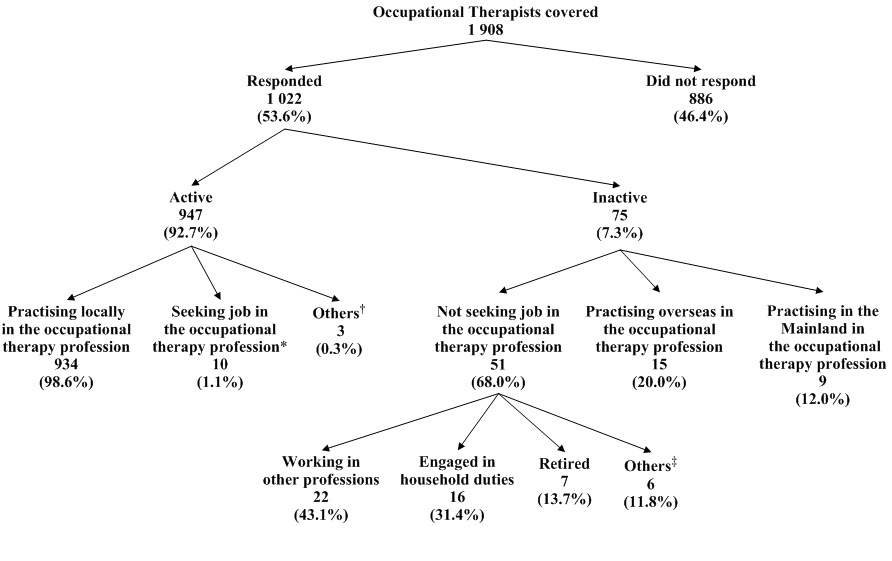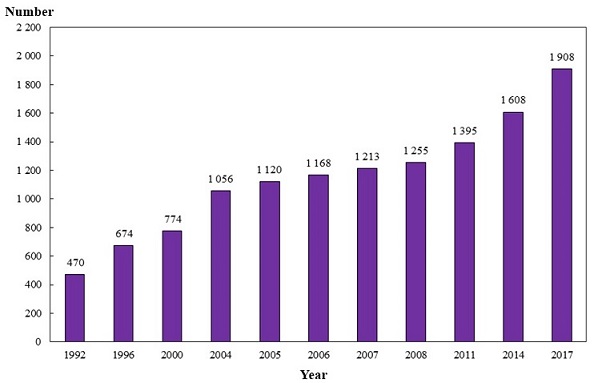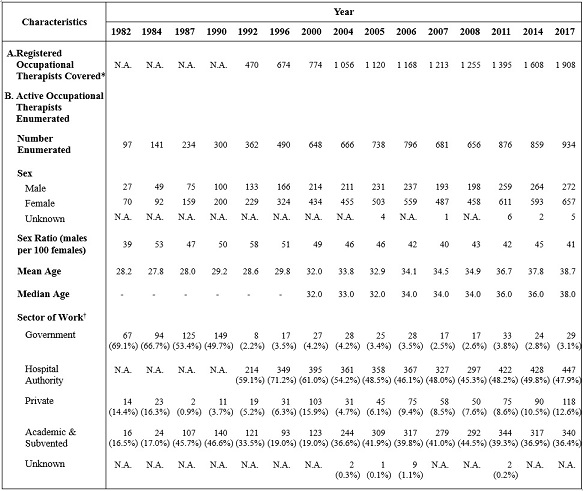Statistics
2017 Health Manpower Survey
Summary of the Characteristics of Occupational Therapists Enumerated
I. Occupational Therapists Covered
1.1 The occupational therapists covered in the 2017 Health Manpower Survey (HMS-OT) were occupational therapists registered with the Occupational Therapists Board of Hong Kong under the Supplementary Medical Professions Ordinance (Chapter 359) as at the survey reference date of 31 March 2017.
1.2 The number of occupational therapists covered was 1 908.
1.3 Of the 1 908 occupational therapists covered, 1 022 responded to the HMS-OT, giving an overall response rate of 53.6%. Among the respondents, 947 (92.7%) were economically active* † (active) and 75 (7.3%) were economically inactive* ‡ (inactive) in the local occupational therapy profession (Chart A) .
1.4 Of the 947 active occupational therapists enumerated, 934 (98.6%) were practising in the local occupational therapy profession, ten (1.1%) were seeking jobs and three (0.3%) believed that work was not available or were having temporary sickness during the 30 days before the survey. The survey results presented in paragraph 1.6 below were based on the 934 responding occupational therapists who were practising in the local occupational therapy profession as at 31 March 2017. The percentages presented below may not add up to 100% due to missing responses or rounding.
1.5 Of the 75 inactive occupational therapists enumerated, 15 (20.0%) occupational therapists reported practising overseas, nine (12.0%) reported practising in the Mainland and 51 (68.0%) occupational therapists reported not practising in the occupational therapy profession in Hong Kong and not seeking job in the local occupational therapy profession during the 30 days before the survey (Chart A) . Among the 51 inactive physiotherapists who reported not seeking job, the main reasons reported for not seeking jobs included: 22 (43.1%) were working in other professions, 16 (31.4%) were engaged in household duties and seven (13.7%) were retired.
* In the survey, the criteria used in defining economically active / inactive followed those recommended by the International Labour Organization, which are also being used by the Census and Statistics Department in Hong Kong.
† "Economically active" occupational therapists comprised all "employed" and "unemployed" occupational therapists. "Employed" occupational therapists referred to those occupational therapists practising in the occupational therapy profession in Hong Kong during the survey period, while "unemployed" occupational therapists referred to those occupational therapists who (a) were not practising in the local occupational therapy profession during the survey period; (b) had been available for work during the seven days before the survey; AND (c) had sought work in the local occupational therapy profession during the 30 days before the survey.
‡ "Economically inactive" occupational therapists comprised the occupational therapists who was not practising in the occupational therapy profession in Hong Kong during the survey period, but excluding those who had been on leave during the survey period and who were "economically active" but "unemployed".
Chart A : Activity Status of Occupational Therapists Covered

|
Note:
|
* | Figure refers to the number of responding occupational therapists who (a) were not practising in the occupational therapy profession in Hong Kong during the survey period; (b) had been available for work during the seven days before the survey; AND (c) had sought work in the local occupational therapy profession during the 30 days before the survey. |
| † | Figure refers to the number of responding occupational therapists who (a) were not practising in the occupational therapy profession in Hong Kong during the survey period; (b) had been available for work during the seven days before the survey; AND (c) believed that work was not available or were having temporary sickness during the 30 days before the survey. | |
| ‡ | Figure refers to the number of responding occupational therapists who reported undertaking study, emigrated or wanted to take rest / had no motive to work/ had no financial need. |
1.6 A total of five occupational therapists did not indicate the gender. Among the remaining 929 active occupational therapists enumerated, 272 (29.3%) were male and 657 (70.7%) were female, giving an overall sex ratio (males per 100 females) of 41.4. Apart from 16 occupational therapists who did not indicate their age, the median age of the remaining 918 active occupational therapists enumerated was 38.0 years. The median age of the active female occupational therapists enumerated was 37.0 years and that of their male counterparts was 39.0 years.
1.7 The responding active occupational therapists were requested to indicate the characteristics of their main jobs*. Distribution by sector for the main job showed that 447 (47.9%) were working in the Hospital Authority, followed by 310 (33.2%) in the subvented sector, 118 (12.6%) in the private sector, 30 (3.2%) in the academic sector and 29 (3.1%) in the Government.
1.8 The median age of the active occupational therapists enumerated was highest for those working in the Government (48.0 years), followed by academic sector (47.0 years), subvented and private sectors (both 38.0 years) and the Hospital Authority (34.0 years).
1.9 Of the 934 active occupational therapists enumerated, 85.3% spent most of their working time on rehabilitation, whilst 9.9%, 2.1%, 1.9% and 0.7% spent most of their time on administration / management, primary health care † , teaching and research respectively.
1.10 The median number of hours of work (excluding meal breaks) per week of the 934 active occupational therapists enumerated was 43.0 hours. Among them, 30 (3.2%) occupational therapists were required to undertake on-call duty (excluding normal duty) per week, with a median of 5.5 hours of on-call duty (excluding normal duty) per week.
1.11 Of the 934 active occupational therapists enumerated, 69.3% held Bachelor’s Degree and 25.9% held Professional Diploma as their earliest basic qualifications.
1.12 Of the 934 active occupational therapists enumerated, 735 (78.7%) received / were receiving additional training. Of the 735 active occupational therapists with additional training, 18 (2.4%) had not yet completed the additional training, 536 (72.9%) held Master’s Degree, 113 (15.4%) held Certificate and 26 (3.5%) held Doctoral Degree as the highest qualification.
* Main jobs referred to the jobs in which the occupational therapists had spent most of their working time.
† Primary health care referred to the work such as health education, health promotion, etc. or the work involving patient care in the primary care setting.
1.13 Of the 735 active occupational therapists enumerated who had received / were receiving additional training, 612 (82.3%) had received / were receiving training in one field only. Among them, 39.4% had received / were receiving additional training in health care (occupational therapy / rehabilitation technology), 25.5% in rehabilitation sciences / studies, 13.9% in health care management / health services management, 8.3% in rehabilitation, 5.2% in counseling and 2.0% in gerontology.
1.14 Among the 735 active occupational therapists enumerated who had received / were receiving additional training, some of them selected more than one field of additional training. The total number of count of active occupational therapists who had received / were receiving additional training was 856, in which 38.3% had received / were receiving in health care (occupational therapy / rehabilitation technology), 26.3% in rehabilitation sciences / studies, 15.2% in health care management / health services management, 7.8% in rehabilitation, 4.1% in counseling and 1.4% in gerontology.
1.15 Regarding Continuing Professional Development (CPD) activities, 719 (77.0%) of the active occupational therapists reported that they had participated in CPD activities in 2017, 197 (21.1%) reported no participation in any CPD activities, whilst 18 (1.9%) did not report whether they had participated in any CPD activities or not. Among the 719 active occupational therapists enumerated who had participated in CPD activities, the distribution of CPD credits attained in the past 12 months was: 1 to 10 credits (35.5%), 11 to 20 credits (34.5%), 21 to 30 credits (17.1%), 31 to 40 credits (3.5%) and more than 40 credits (9.5%).
II. Trend Analysis
2.1 Comparison of findings of the 2017 HMS-OT with those surveys conducted before 2004 should be made with caution as the survey methods and reference date had been changed.
2.2 Since the enactment of the Occupational Therapists (Registration and Disciplinary Procedure) Regulations (Chapter 359B), registration of the profession of occupational therapists commenced on 1 October 1990 while disciplinary control of the profession was effective on 1 August 1991, it is mandatory for a person practising occupational therapy in Hong Kong to hold a valid practising certificate. Between 1992 and 2017, the number of occupational therapists increased from 470 to 1 908 (Chart B) .
2.3 Since 1982, the sex ratio (males per 100 females) of active occupational therapists enumerated has been fluctuating in the range between 39 and 58. The sex ratio (males per 100 females) was maintained at a range between 40 and 45 in the recent decade (Table A) .
Chart B : Number of Registered Occupational Therapists Covered by Year (1992, 1996, 2000, 2004, 2005, 2006, 2007, 2008, 2011, 2014 and 2017)

| Note: | Figures of the year 2000 and before refer to the number of occupational therapists registered with the Occupational Therapists Board of Hong Kong as at the 1 July of the respective years, whereas the figures of 2004 to 2017 refer to that as at the 31 March of the respective years. |
2.4 The mean age of the active occupational therapists enumerated increased gradually from 28.2 years in 1982 to 38.7 years in 2017.
2.5 From 1982 to 1990, the largest proportion of active occupational therapists enumerated was working in the Government, followed by the academic and subvented sectors, which together accounted for more than 80% of all the occupational therapists. The Hospital Authority had been the largest working sector since its establishment in 1991, while the proportion of active occupational therapists enumerated working in Hospital Authority gradually decreased from 59.1% in 1992 to 47.9% in 2017. On the other hand, the proportion of active occupational therapists enumerated working in the private sector increased from 5.2% in 1992 to 12.6% in 2017.
Table A : Selected Characteristics of Active Occupational Therapists Enumerated (1982, 1984, 1987, 1990, 1992, 1996, 2000, 2004, 2005, 2006, 2007, 2008, 2011, 2014 and 2017)

|
Note:
|
* | Figures of the year 2000 and before refer to the number of occupational therapists registered with the Occupational Therapists Board of Hong Kong as at the 1 July of the respective years, whereas the figures of 2004 to 2017 refer to that as at the 31 March of the respective years. |
| † | In 2004, 2005, 2006, 2007, 2008, 2011, 2014 and 2017, the sector refers to the sector for the main job. | |
| There may be slight discrepancy between the sum of individual items and the total due to rounding. | ||
| N.A. Not applicable. | ||
| ‘ - ’ Not available. |